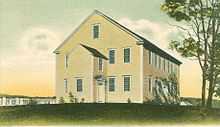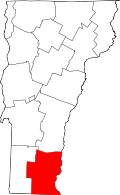Rockingham, Vermont
| Rockingham, Vermont | |
|---|---|
| Town | |
|
Pleasant Valley Grange Hall, next to the Rockingham Meeting House | |
 Rockingham, Vermont | |
| Coordinates: 43°9′57″N 72°28′54″W / 43.16583°N 72.48167°WCoordinates: 43°9′57″N 72°28′54″W / 43.16583°N 72.48167°W | |
| Country | United States |
| State | Vermont |
| County | Windham |
| Chartered | 1752 |
| Area | |
| • Total | 42.3 sq mi (109.6 km2) |
| • Land | 41.9 sq mi (108.5 km2) |
| • Water | 0.4 sq mi (1.1 km2) |
| Elevation | 1,037 ft (316 m) |
| Population (2010) | |
| • Total | 5,282 |
| • Density | 123.1/sq mi (48.7/km2) |
| Time zone | Eastern (EST) (UTC-5) |
| • Summer (DST) | EDT (UTC-4) |
| ZIP code | 05101 |
| Area code(s) | 802 |
| FIPS code | 50-60250[1] |
| GNIS feature ID | 1462189[2] |
Rockingham is a town in Windham County, Vermont, United States, along the Connecticut River. The population was 5,282 at the 2010 census. Rockingham includes the incorporated villages of Bellows Falls and Saxtons River, as well as a large rural area west of Interstate 91.
Rockingham has no formal town center, instead town offices and the Rockingham Public Library are located in the village of Bellows Falls. The listed center of town is on Route 103, a popular east-west route across the state, the location of the Rockingham Meeting House.
History

One of the New Hampshire grants, it was chartered by Governor Benning Wentworth on December 28, 1752 and named for Lord Rockingham. The township was granted to Samuel Johnson and 72 others. First settled in 1753, pioneers fished for salmon and shad.[3] By 1771, the population reached 225. In 1785, Colonel Enoch Hale erected the first bridge over the Connecticut River, and until 1796, it remained the only bridge across.[3] The village of Bellows Falls became an important mill town.
Geography
According to the United States Census Bureau, the town has a total area of 42.3 square miles (109.6 km2), of which 41.9 square miles (108.5 km2) is land and 0.4 square mile (1.1 km2) (0.97%) is water. Drained by the Williams River, Rockingham is bounded on the east by the Connecticut River.
It is crossed by Interstate 91, U.S. Route 5, Vermont Route 103 and Vermont Route 121.
Demographics
As of the census[1] of 2000, there were 5,309 people, 2,202 households, and 1,387 families residing in the town. The population density was 126.7 people per square mile (48.9/km2). There were 2,425 housing units at an average density of 57.9 per square mile (22.3/km2). The racial makeup of the town was 97.38% White, 0.34% African American, 0.09% Native American, 0.55% Asian, 0.06% Pacific Islander, 0.26% from other races, and 1.32% from two or more races. Hispanic or Latino of any race were 1.15% of the population.
There were 2,202 households out of which 31.1% had children under the age of 18 living with them, 47.2% were couples living together and joined in either marriage or civil union, 12.0% had a female householder with no husband present, and 37.0% were non-families. 30.1% of all households were made up of individuals and 13.4% had someone living alone who was 65 years of age or older. The average household size was 2.39 and the average family size was 2.96.
In the town the population was spread out with 25.1% under the age of 18, 6.8% from 18 to 24, 27.1% from 25 to 44, 25.5% from 45 to 64, and 15.4% who were 65 years of age or older. The median age was 39 years. For every 100 females there were 93.8 males. For every 100 females age 18 and over, there were 88.6 males.
The median income for a household in the town was $33,423, and the median income for a family was $45,503. Males had a median income of $29,200 versus $22,944 for females. The per capita income for the town was $19,051. About 4.8% of families and 10.0% of the population were below the poverty line, including 13.5% of those under age 18 and 9.6% of those age 65 or over.
Listed on National Register of Historic Places

- Bartonsville Covered Bridge — across the Williams River at the southern end of Bartonsville (added August 2, 1973)
- Parker Hill Rural Historic District — Parker Hill and Lower Parker Hill Roads (added June 20, 1993)[4]
- Rockingham Meeting House — off Vermont Route 103 (added October 10, 1979)
- Williams River Route 5 Bridge — U.S. Route 5 over the Williams River (added December 14, 1991)
- Worrall Covered Bridge — north of Rockingham across the Williams River (added August 16, 1973)
Notable people
- John S. Barry, fourth governor of Michigan
- Henry Adams Bellows, lawyer, state Congressman and jurist
- Jonathan Blanchard, pastor, social reformer, and president of Wheaton College
- Daniel Kellogg, United States Attorney for the District of Vermont and Justice of the Vermont Supreme Court[5]
- George Bradley Kellogg, Adjutant General of the Vermont National Guard, Lieutenant Colonel of the 1st Vermont Cavalry Regiment in the American Civil War[6]
- Selim Peabody, educator
- Shadrach Roundy, religious leader
- Henry Franklin Severens, judge
References
- ↑ 1.0 1.1 "American FactFinder". United States Census Bureau. Retrieved 2008-01-31.
- ↑ "US Board on Geographic Names". United States Geological Survey. 2007-10-25. Retrieved 2008-01-31.
- ↑ 3.0 3.1 A. J. Coolidge & J. B. Mansfield, A History and Description of New England; Boston, Massachusetts 1859
- ↑ Description of Parker Hill from National Register Nomination Information
- ↑ Hiram Carleton, Genealogical and Family History of the State of Vermont, Volume 1, 1903, page 286
- ↑ Lyman Simpson Hayes, History of the Town of Rockingham, Vermont, 1907, page 691
Further reading
External links
| |||||||||||||||||||||||||||||
| ||||||||||||||||||||||||||||||||||

